In my garden, we no longer cut down every perennial plant in the fall. As in nature, many perennials find that their dying leaves protect them from the cold and provide natural fertilizer. Let’s talk about which perennials to tackle, which to leave, as well as when and how to cut back perennials properly.
Advertisement
When to Cut Back Perennials
It’s obvious when it’s time to pull out annual flowers; they’re one-hit wonders and turn black and die after the first frost.
When it comes to perennials, don’t be in a rush to cut things down; hold off until after several hard frosts. Even if the flowers or leaves are dead, the roots are reclaiming energy from the dying plant for healthy growth in the spring.
Technically, very few plants MUST be cut down in the fall. We enjoy leaving as many flower seedheads standing as possible to add both winter interest as well as feed the birds in cold weather. If you follow nature’s lead, the decomposing leaves not only insulate the plant during the winter freezes and thaws but also decompose to provide excellent (and free) fertilizer, saving you time and money in the spring.
However, there are cultivated plants which are more susceptible to problems if the old foliage and dying stems are left to rot. Diseases can overwinter in dead foliage, as can slugs and other pests. Old stems can also get battered about by fall and winter winds, which will damage the plant’s crown and roots.
Also: Always cut back any infected or diseased plants! Badly damaged or infested foliage should be cut back and removed from infected plants.
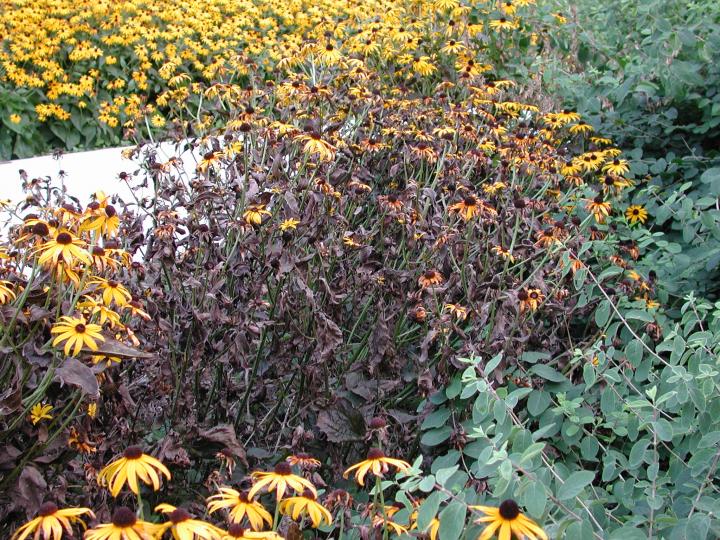 Image: Septoria leaf spot lesions on rudbeckia leaves. Remove and destroy as soon as possible. Credit: Purdue University.
Image: Septoria leaf spot lesions on rudbeckia leaves. Remove and destroy as soon as possible. Credit: Purdue University.
Which Perennials to Cut Back
There are a few perennials which we recommend cutting back, namely:
- Bee balm and phlox which are prone to powdery mildew, so cut them all back once the flowers finish.
- Peonies to keep fungal diseases from spreading. Gather a handful of stems and cut them off 2 to 3 inches above the soil.
- Hosta foliage after a hard frost, including any leaves on the ground, as they may harbor slug eggs and prevent new spring growth. Don’t cut the leaves all the way to the ground, though. Instead, leave about 2 to 3 inches of each stem standing to protect the crown during winter.
- Bearded iris need a clean garden bed to stay disease free. The iris borers’ eggs overwinter on leaves and stems of the mother plant; by cutting the leaves back and destroying them, you can help reduce or even eliminate borers from your garden. Wait until after the first frost because the iris borer moth remains active until then.
If it bothers you to keep the dead and dying perennials standing in your garden bed, see this list of perennials that can be cut down in the autumn. Basically, most plants that flower in early spring or summer can be cut down in the fall.
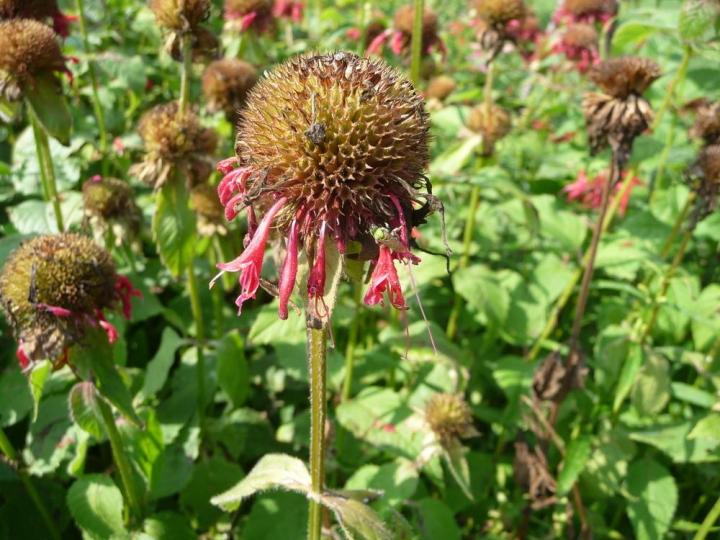 Image: Bee Balm
Image: Bee Balm
How to Cut Back Perennials
After several hard frosts, remove spent flowers and stems by cutting stems off near the base of the plant, allowing the crown (base of plant) to remain. Bypass pruners are preferred because they make a clean cut through the stem of the plant, whereas anvil pruners crush the stem, leaving more damage behind.
I usually leave 6-inch stubs so I can find the plants next spring. Don’t go any lower than 2-inch stubs; you don’t want to accidentally dig into plants that emerge late, like butterfly weed, rose mallow, and balloon flower. You will be less likely to dig into them accidentally before they appear in spring if you can see a portion of their stalks.
Note: Some late summer or fall perennials and biennials may have already started to form leaves for next year at the base of the plant. Examples include yarrow, foxglove, Shasta daisy, and globe thistle. When cutting back, be sure to leave these rosettes of green. Cut off the stalks without disturbing this new growth.
After cutting back your plants, apply a light mulch. Then, wait to feed until the spring for healthy growth.
Don’t Be Afraid to Leave Some Winter Interest!
Again, try leaving some seedheads standing for winter interest or to feed the birds. Here are some favorites:
- The blackberry lily (Belamcanda) looks great until heavy wet snow finally knocks it down.
- Ornamental grasses add movement and sound to the landscape.
- I let the agastaches, coneflowers, and rudbeckia stand through winter for the birds to enjoy. See plants with seedheads to feed the birds.
- Native sedum, Joe Pye weed, and oxeye sunflower (Heliopsis helianthoides) can all wait until spring to be cut back, when new growth arrives. In addition to the birds, butterflies and beneficial insects shelter in these native plants and their leaf litter.
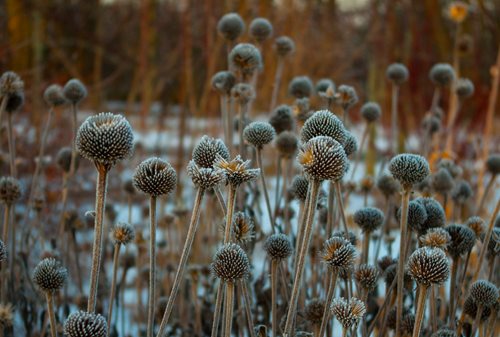 Image: Beautiful coneflower seedheads add visual interest and food for the birds and wildlife.
Image: Beautiful coneflower seedheads add visual interest and food for the birds and wildlife.
If you simply don’t want certain plants to reseed, snip spent flowers back just below the mound of foliage for a tidy look. Perennials that will self-seed include:
- Purple coneflower (Echinacea)
- Black-eyed Susan (Rudbeckia)
- Blanket flower (Gaillardia)
- Globe thistle (Echinops ritro)
- Solomon’s seal (Polygonatum)
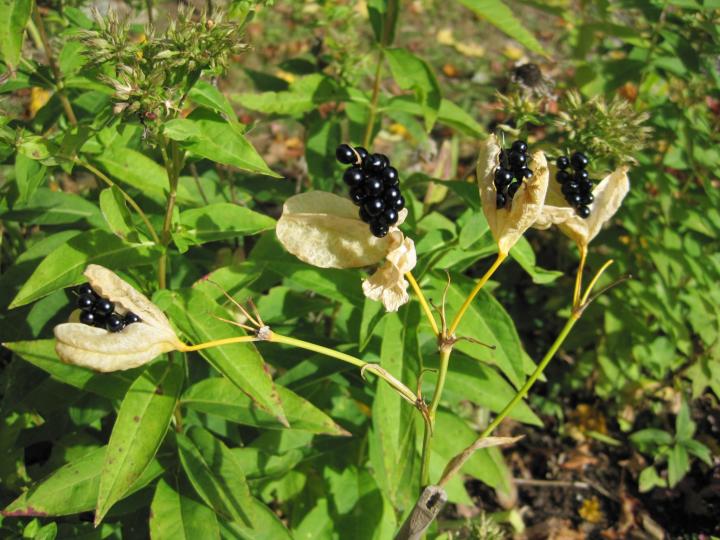 The blackberry lily produces seedheads full of glossy black “berries.”
The blackberry lily produces seedheads full of glossy black “berries.”
Perennials NOT to Cut Back
Some perennials, including evergreen perennials such as epimediums, hellebores, heucheras, hardy geraniums, dianthus, moss phlox, and euphorbias, should be left alone. Candytuft, primulas, hens & chicks, heaths, and heathers are also considered evergreen and should not be cut back in the fall. Tidy them in the spring as needed.
Also, do not cut back hardy perennials like garden mums (Chrysanthemum spp.), anise hyssop (Agastache foeniculum), red-hot poker (Kniphofia uvaria), and Montauk daisy (Nipponanthemum nipponicum). Leave the foliage. It’s important to protect the root crowns over winter. Cutting back the plants severely will simulate late new growth, which will be very susceptible to winter kill.
Pulmonaria and penstemons should also be left in place until spring.
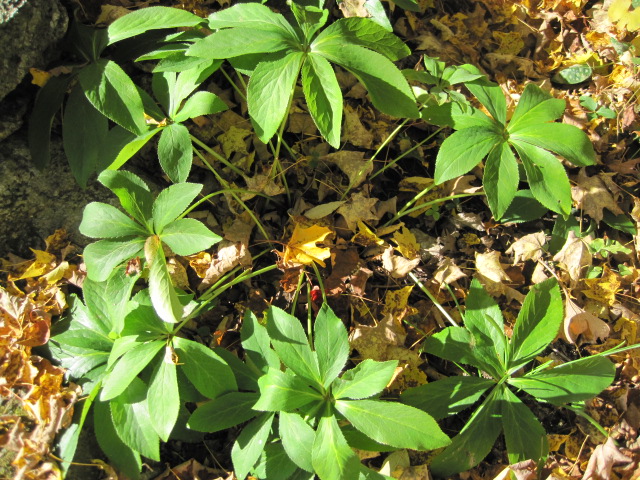 This hellebore is considered an evergreen and should not be cut back in the fall
This hellebore is considered an evergreen and should not be cut back in the fall
Clean Up Garden Debris
As with the vegetable garden, any diseased or bug infested plant material needs to go—far away! Don’t put it in the compost pile. Debris from things like rusty hollyhocks, peonies with powdery mildew, leaf-spotted delphiniums, and other fungal-infected flowers should be removed from the garden.
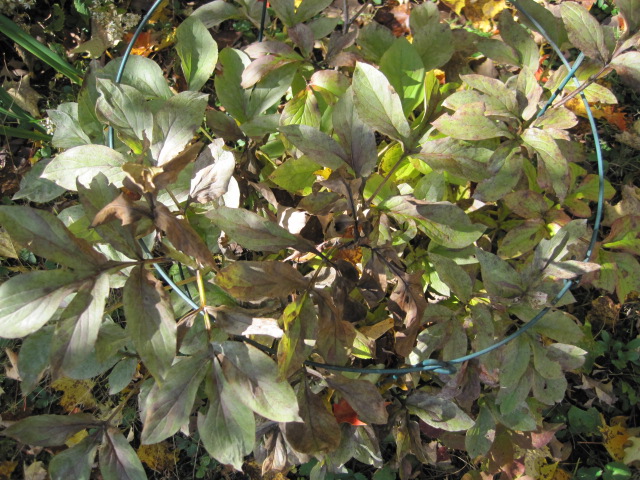 Leaves from a peony infected with powdery mildew should not be composted.
Leaves from a peony infected with powdery mildew should not be composted.
Don’t Fertilize in the Fall
Fertilizing in autumn encourages new growth that will just get killed when cold weather hits. Compost is not considered a fertilizer; it is a soil conditioner, so feel free to add that in the fall. If your soil test indicates that you need lime, it can be applied in the fall also.
Weed Before the Freeze
Before the ground freezes, do a final weeding. The more weeds you can get out now, especially those that have seeds, the fewer weeds you’ll have to deal with in the spring. Edge your beds for one last time and you’ll start the year with a neat and tidy look.
To Mulch or Not to Mulch?
If you are growing plants that are hardy in your zone and live where snow cover is plentiful each winter, you probably don’t have to worry about mulching your garden, though it’s always insurance to give them some extra protection. It’s newly planted perennials that are the exception. Definitely tuck some mulch around them for their first winter.
The purpose of a winter mulch is to keep the soil temperature even and prevent heaving of roots due to alternate freezing and thawing of the ground. Waiting until the ground is frozen before mulching is not only best for your plants but also discourages rodents from making a cozy home there. Use a mulch that does not pack down and smother your plants. Shredded leaves, pine needles, straw, or evergreen boughs are good choices. Snow provides the best insulating mulch, it goes down gradually and melts gradually.
Learn more about mulching your garden.
Watering the Garden
If you live where it has been dry this growing season, keep watering your garden until the ground freezes. Usually there is plentiful moisture in the fall, but many areas have experienced drought conditions in recent summers and the ground is dry. Plants that are water stressed will have a tough time surviving the winter.
The more work you do in your perennial garden this fall, the less you’ll have to do next spring!
See more about overwinterizing plants in the garden—from roses to rosemary.



 Image: Septoria leaf spot lesions on rudbeckia leaves. Remove and destroy as soon as possible. Credit: Purdue University.
Image: Septoria leaf spot lesions on rudbeckia leaves. Remove and destroy as soon as possible. Credit: Purdue University. Image: Bee Balm
Image: Bee Balm Image: Beautiful coneflower seedheads add visual interest and food for the birds and wildlife.
Image: Beautiful coneflower seedheads add visual interest and food for the birds and wildlife. The blackberry lily produces seedheads full of glossy black “berries.”
The blackberry lily produces seedheads full of glossy black “berries.” This hellebore is considered an evergreen and should not be cut back in the fall
This hellebore is considered an evergreen and should not be cut back in the fall Leaves from a peony infected with powdery mildew should not be composted.
Leaves from a peony infected with powdery mildew should not be composted.







Comments